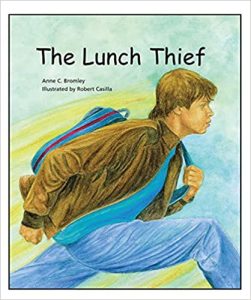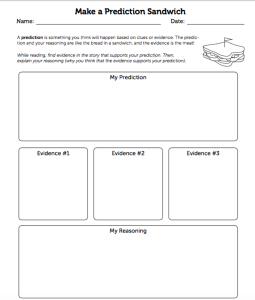Anti-Poverty

Author(s): Anne C. Bromley and Robert Casilla
Links:
Amazon: https://amzn.to/3b2PzUT
Indigo: https://bit.ly/2WkFxsM
Social Justice focus: Poverty
Synopsis: Someone stole Rafael’s lunch, leaving him quite hungry. His mom packed his lunch bag and it contained two burritos, a bag of corn chips, some carrots, and an apple. Rafael saw Kevin, a new student in his class, sneak his lunch bag from underneath his desk and tuck it in his backpack. Rafael is never one to fight, so he tried to find another solution. Inspired by his mother’s advice to “use your mouth before your fists,” Rafael bides his time, but other kids’ lunch are disappearing too. While running errands with his mom, Rafael sees Kevin carrying a basket of laundry into a motel room, and his mom tells him Kevin’s family might be one of the families who lost their homes in the recent wildfires. The next day, instead of accusing Kevin, Rafael invites him to share his lunch, offering a friendship as well as lunch.
Lesson Plan: Nick Bruccoleri
Primary/Junior/Intermediate Lesson Plan (Abbreviated Template)
Consecutive and Concurrent Programs
Unit/Topic: Social Justice/ Prediction
Grade: 4
Lesson: What is the focus of this lesson in relation to the unit?
Students will begin to understand how students in a classroom have unique stories and it may not be similar to their own, also, how to understand why some people do the things they do.
Curriculum Areas: What are possible connections to other curricular areas?
Language Arts:
C1 Knowledge about Texts
C1.1 Using foundational knowledge and skills to comprehend texts
C2 Comprehension Strategies
C2.3 Monitoring of understanding: Making and confirming predictions
C2.5 Monitoring of understanding: Ongoing comprehension check
Health: Healthy Living/ nutrition
Curriculum Expectations: What Overall and Specific Expectations will be addressed?
Literacy Overall Expectations:
- read and demonstrate an understanding of a variety of literary, graphic, and informational texts, using a range of strategies to construct meaning;
Literacy Specific Expectations
1.4 Demonstrate understanding of a variety of texts by summarizing important ideas and citing supporting details
1.5 Make inferences about texts using stated and implied ideas from the texts as evidence
1.6 Extend understanding of texts by connecting the ideas to their own knowledge, experience, and insights, to other familiar texts, and to the world around them
1.7 Analyze texts and explain how specific elements in them contribute to meaning
Health Overall Expectation:
D3. demonstrate the ability to make connections that relate to health and well-being – how their choices and behaviours affect both themselves and others, and how factors in the world around them affect their own and others’ health and well-being.
Health Specific Expectations:
D3.1 Identify ways of promoting healthier eating habits in a variety of settings and situations
Learning Goal(s): What are students expected to know, do and understand? We are learning to….
- I can look at the cover, title and illustrations in the book to predict the ending of the story
- I understand the connection of nutrition (from the news article) to the story The Lunch Thief
- I can draw on personal experiences to resonate with Rafael/ and or Kevin
- I can read the story to identify certain themes
Success Criteria: How will students know they have met the learning goal? I can….
- I will ask questions if I do not understand a word or phrase
- I can read silently
- I can participate in partner discussion by sharing my opinion
- I will actively listen to the story when it is being read to me
MODIFICATIONS / ACCOMMODATIONS: How will I meet the needs of my students? Have I addressed any IEPs?
N/A
Minds-on: How will I connect to prior and future learning? How will I engage students and set the context for learning?
Minutes: How much time will I allocate? 15 minutes
Task: What will I be doing? What will students be doing?
Inform students that they will be reading a short story entitled the The Lunch Thief and that there is an emphasis on the need for a nutritional diet in order to learn and grow as a student.
Students will read the following news article:
https://www.publicschoolreview.com/blog/how-diet-and-nutrition-impact-a-childs-learning-ability
Students will be asked to read the news article provided, which talks about the benefits of students eating “healthy” foods and what effect it has on student’s learning. After reading the article, students will then be asked to do a think-pair-share with their elbow partner to discuss why they think it is important to eat properly and if they have any personal experiences of a time, they think being hungry effected their learning.
Assessment: What is the Nature and Purpose of assessment?
Assessment as learning: Students will be assessing their own learning through discussion with a partner to see what each individual was capable of pulling from the article and ability to draw on personal experiences.
Action: How will I introduce new learning / reinforce prior learning / practice learning / scaffold learning?
Minutes: How much time will I allocate? 55 minutes
Task: What will I be doing? What will students be doing?
Read aloud The Lunch Thief until page 22. Inform the student to pay attention the illustrations and to listen carefully to determine what is happening in the story.
After each page, stop and ask the students: “What is happening?” the follow up question would be “How do we know this?”
If there are any words you think students may not understand, stop and explain the word. (first ask the class to see if any students know.. explanation from teacher is last resort).
Once you have reached page 22, ask the students what they think is going to happen next in the book based on the pages they have already read. Provide students with the handout attached to the lesson which students will have to complete based on the story.
Make sure to walk through the worksheet with the students so they understand the expectations. Students will first have to determine what they think the ending of the book is. They then have to provide three pieces of information that led them to think of their ending (the proof), this could come from the illustrations or the text. Last, students will then have to explain why they think their proof supports their ending.
AFTER ALL STUDENTS HAVE COMPLETED THE WORKSHEET you can then continue to read the rest of the story to the students.
Upon completion of the story, have a group discussion on whether the endings they had come up with are close to what happened in the book.
Continue the discussion by asking what types of themes they can see in this short story (probe for nutrition and how some students do not have the same opportunity of receiving proper nutrition like some students do.
Assessment: What is the Nature and Purpose of assessment?
Assessment for learning: During class discussion anecdotal note taking will take place to see the students ability to identify theme and ability to use proof from text to come up with their own ending of the book.
Consolidation: How will I reflect on the learning goal? How will I have students reflect on the learning goal?
Minutes: How much time will I allocate? 10 minutes
Task: What will I be doing? What will students be doing?
Students will complete an exit card, the objective is to make connections between the article about nutrition and the story (2-3) connections.
Assessment: What is the Nature and Purpose of assessment?
Assessment for learning: students will show their ability to make text-to-text connections between the story and news article. Upon collection of exit tickets, students will be given written feedback.
_______________________________________________________
MATERIALS: What resources and materials do I need? Where can I find them? In a perfect world what other resources might I need?
- Copy of The Lunch Thief (hard copy or online for smart board)
- Class set of worksheets (provided below)
- Copy of news article (most likely online)


